Athenian red-figure cup attributed to Oltos, examination of the liver of a sacrificial victim

Athenian red-figure cup attributed to Oltos examination of the liver of a sacrificial victim (‘hieroscopy’), c.500 B.C.Cervetri, Museo Nazionale Cerite Photo: Jaime Ardiles-Arce – Representation of warfare is a feature of Greek painted pottery from the earliest figurative images from the eighth century BCE. In the second half of the sixth century and into the […]
Athenian red-figure krater signed by Euphronios

Athenian red-figure krater signed by Euphronios death of Sarpedon c.500 B.C. Cervetri, Museo Nazionale CeritePhoto: Jaime Ardiles-Arce, CC0 1.0 Universal (CC0 1.0) – This pot has become particularly famous because it was illegally excavated and then acquired by the Metropolitan Museum in New York. The Met. subsequently agreed that its acquisition had been inappropriate and the […]
Terracotta anatomical votive; spiral coil ending in trefoil

Terracotta anatomical votive; spiral coil ending in trefoil. Tivoli/Lazio, 3rdC BC-1stC BC © The Trustees of the British Museum Museum Number 1899,0720.13 CC BY-NC-SA 4.0 – This terracotta votive nicely combines the clean volumetric rotundity of the belly with the coiled shape of the imagined innards (intestines? the uterus? the spiral image as an abstract […]
Terracotta anatomical votive

Terracotta anatomical votive 3rdC BC-1stC BC © The Trustees of the British Museum, Museum Number 1839,0214.51CC BY-NC-SA 4.0 – This image represents an inner part; some of the features, such as the ribs and wrinkles and the central globe, point to a womb as an ‘empty sack’, a container ready to receive the embryo; on […]
Apollo the Python-Slayer or Cleveland Apollo

Apollo the Python-Slayer or Cleveland Apollo Hellenistic (?) Courtesy of the Cleveland Museum of Art. Museum Number 1839,0214.51 – The celebrated Cleveland Apollo is one of the most famous works attributed to the fourth-century Attic sculptor Praxiteles. Many later marble copies survive, but this bronze classical piece came to public attention only in 2004 when […]
Grotesque figurine

Grotesque terracotta figurine 3rd century BCE–3rd century CE (?) © 2023, Benaki Museum, Athens. Benaki Museum inv. No 12793 – This Hellenistic terracotta, part of the Benaki Museum collection in Athens, depicts with hyper-realistic traits an old, and/or ‘disabled’ man with a protruding pot belly, achieving a grotesque effect and signalling a pathology while offering […]
Marble tombstone of an Athenian physician

Athens, 2nd century CE
